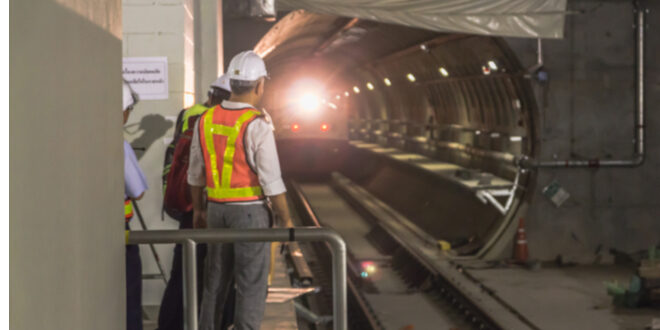The proposed Ontario Airport Loop would connect the airport to Rancho Cucamonga’s Metrolink Station. The four-mile tunnel would cost about $85 million, a fraction of what an above-ground system would cost.
Negotiations to build an underground transit service between Rancho Cucamonga’s Metrolink station and Ontario International Airport are underway.
The San Bernardino County Transportation Authority voted recently to begin talks with the The Boring Co., a tunnel and underground infrastructure firm in Los Angeles founded by Elon Musk.
Boring was the only company to respond to the transportation authority’s request for qualifications regarding construction of the four-mile tunnel. When completed, the project will connect Metrolink’s busiest route with one of the fastest growing airports in the United States, according to a statement issued after the authority gave the project its unanimous approval.
The vote came one month after the transportation authority awarded a construction management services contract to HNTB Corp., a Kansas City-based infrastructure design company.
Operation could start by 2023 or 2024. The project, expected to cost $85 million, would use electric zero-emission vehicles to move about 1,200 passengers on a typical day.
Boring, which Musk founded in 2016, builds tunnels for public transportation and freight movement. It’s building one underground project in Las Vegas similar to the proposed Rancho Cucamonga-Ontario International project, and it’s conducting feasibility studies on the Dugout Loop, which would move patrons from several communities in Los Angeles to Dodger Stadium.
An above-ground transit system along the same route would cost approximately $1.2 billion, said Ray Wolfe, the transportation authority’s executive director.
“That’s quite a bit of savings,” Wolfe said. “Underground is always cheaper no matter where you do it.”
Assuming both parties can come to an agreement, a final contract could be ready for the board’s approval in September, Wolfe said.
Should that happen, it would not be enough to start construction. The project must still get state and federal environmental approval under the California Environmental Quality Act and the National Environmental Policy Act, respectively.
Ontario International attracts five to six million passengers a year, which is probably not enough traffic to make the airport loop project vital now, Wolfe said.
But airport officials expect to reach a yearly passenger count of 15 to 20 million, at which point that connection will be crucial to keeping Ontario International running smoothly.
“Ontario International Airport is one of the aviation industry’s greatest success stories and a critical economic driver for our region,” said Alan D. Wapner, Ontario’s Mayor pro tem and president of the Ontario International Airport Authority’s board of commissioners, in a statement. “We need to take steps now to ensure that we can adequately handle our continued long-term growth and avoid the kinds of congestion issues that have become a significant problem for other airport communities.”
Wolfe agreed, saying it’s correct to construct the tunnel now while the funding is available and before traffic at Ontario International becomes overwhelming as it often is at Los Angeles International.
“We probably don’t need the tunnel now, but before too long we will,” Wolfe said. “We’re trying to avoid becoming the traffic nightmare that Los Angeles International is, and this will help us do that. It will make it a lot easier to get in and out of Ontario International.”
“It will also get some cars off the freeways, and people won’t have to pay $18 to $30 a day to park here.” Wolfe continued.
The Boring Co.’s proposal would build the tunnel south from the Metrolink Station, located at 11208 Azusa Court, below Milliken Avenue to Airport Drive. From there it will turn west and conclude at Terminal 4. Stations are expected to be built at the Metrolink station and at terminals 2 and 4, but those could be temporary, Wolfe said.
The authority also secured space for an underground station, but that is not scheduled to be built yet, according to an authority staff report.
Besides providing high-speed access between Rancho Cucamonga and the airport, the underground “loop” will help connect all rail systems in San Bernardino and Los Angeles counties, said Frank Navarro, transportation authority president and Colton mayor.
Rancho Cucamonga’s Metrolink station is a hub for the much-traveled San Bernardino line, and that line is about to get more crowded with the addition of the “Arrow.”
That project, formally known as the Redlands Passenger Rail Project, is being built by Metrolink. It will run from the San Bernardino Transit Center downtown to the University of Redlands.
Service is expected to start next year, well before the Rancho Cucamonga-to-Ontario International project is ready, but ultimately the underground “Loop” will help ease the extra passenger load created by “Arrow.”
“Any link you create between commuter lines is a good thing,” Navarro said. “It’s good for commuters and it’s good for the communities involved. It’s a win-win for everyone.”
The Ontario Airport Loop will make it easier for rail passengers to move been western San Bernardino County and Los Angeles County, according to one transit official.
Stephanie Wiggins, Chief Executive Officer for Metrolink, concurred with that assessment.
“This is one of the most important transportation corridors in all of Southern California,” said Stephanie Wiggins, Metrolink’s chief executive officer, in a statement. “The Ontario Airport Loop creates tremendous opportunities to create convenient access between Ontario International Airport and Los Angeles County, eastern San Bernardino County and the region as a whole.”
 IE Business Daily Business news for the Inland Empire.
IE Business Daily Business news for the Inland Empire.


